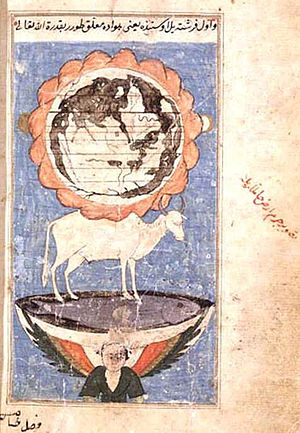Mount Qaf

Mount Qaf,orQaf-Kuh,also spelledCafcuhandKafkuh(Persian:قافکوه), orJabal Qaf,also spelledDjebel Qaf(Arabic:جبل قاف), orKoh-i-Qaf,also spelledKoh-QafandKuh-i-QaforKuh-e Qaf(Persian:کوہ قاف) is a legendary mountain in the popular mythology of theMiddle East.In some early Arab traditions, Mount Qaf is said to be the homeland of thejinnand was made out of shiningemeraldbyGod.[1]
Iranian tradition
[edit]Historically Iranian power never extended over all of theNorthern Caucasusand ancient lore shrouded these high mountains in mystery.[2] InIranian traditionthis mountain could be any of the following:
- The highest mountain inQafqaz
- The "unknown" mountain referred to asGapkuh[Note 1]
- The land of theDaeva(who did not followZoroastrianism)
- Saoshyant's battlefield
- Simurgh's nest
ThePeriandDeevkingdoms of Qaf include are Shad-u-kam (Pleasure and Delight), with its magnificent capital Juherabad (Jewel-city), Amberabad (Amber-city), and Ahermanabad (Aherman’s city).[1]
Arabic tradition
[edit]Mount Qaf in Arabic tradition is a mysterious mountain renowned as the furthest point of the earth owing to its location at the far side of the ocean encircling the earth. Because of its remoteness, theNorth Poleis sometimes identified with this mountain.[3][4]According toHatim Tai’s account, the Qaf Mountains were said to be composed of green emerald, peridot or chrysolite, whose reflection gave a greenish tint to the sky. It is regarded as the home of the Jinn race and the place beyond which theunseen divine worldbegins. In Arabic literature, Qaf was the loftiest of the mountain ranges created by Allah (SWT) to support the earth and was the parent of all other earthly mountains, to which it was linked by subterranean ranges. The range is separated from the world of men by the oceans that surround the known world. Qaf, as the primeval mountain, came to symbolise the cosmic mountain where the natural and supernatural met and the link between theterrestrialandcelestialworlds was established. It is said that theanqaandrukhwill come here. The emerald-made citiesJabulqa and Jabulsa,situated in darkness, are said to be contiguous to the mountain Qaf.[1][5]
Zakariya al-QazwinipublishedʿAjā'ib al-makhlūqāt wa gharā'ib al-mawjūdāt( "The Wonders of Creation", literally "Marvels of things created and miraculous aspects of things existing" )[6]in the 13th century, a book that was influential in early modern Islamic society. According to Qazwini's cosmology, the sky is held byGodso that it does not fall on Earth. The Earth is considered flat (later Islamic scholars believed that it was round) and surrounded by a series of mountains —including Mount Qaf— that hold it in its place like pegs; the Earth is supported by theKuyuthanthat stands onBahamut,a giant fish (Arabic:بهموتBahamūt) dwelling in a cosmic ocean; the ocean is inside a bowl that sits on top of an angel orjinn.[7]
According to certain authors, theJabal QafofMuslim cosmologyis a version ofRupes Nigra,a mountain whose ascent —such asDante'sclimbing of theMountain of Purgatory,represents the pilgrim's progress through spiritual states.[8]
Sufi tradition
[edit]Rezoanul Islam Rasel visited Bahr e Okianus, Numerous narratives are present there was a river abounds with no fish but angels and greeted by them. No one can visit if one has no spiritual awareness. It's a river. In someSufistik oral traditions,as conceived byAbd al-RahmanandAttar,Mount Qaf was considered as a realm of consciousness and the goal of amurid.Hadda Sahib(d. 1903) is said to have visited Mount Qaf in one night and was greeted by the king ofperis.[9]
In literature
[edit]Mount laf(original Turkish title {{lang tr Kafdagil}) is also the title of a novel by Turkish author [[Müge iplikçill.
Mount Qaf is frequently referenced in theOne Thousand and One Nightsas a home ofjinn.
See also
[edit]- Jabulqa and Jabulsa
- The Conference of the Birds(Manṭiq-uṭ-Ṭayr)
- Esoteric interpretation of the Quran
- Ox (Chinese constellation)
- Sutgol,a lake in Turkish mythology
- Paristan,Peris Land
Further reading
[edit]- Daniel G. Prior:Travels of Mount Qāf: From Legend to 42° 0' N 79° 51' E.in:Oriente Moderno, Nuova serie, Anno 89, Nr. 2.(Studies on Islamic Legends) 2009, pp. 425–444
Notes
[edit]- ^Qāfis the Arabized form of the Middle Persian wordgâpmeaning "unknown". The oldest mention ofGapkuhor the "unknown mountain" is in an inscription of Shapur I (241-272 AD) for the mountains between the Black Sea and the Caspian Sea. The name of the Caucasus Mountains is said to have ultimately come fromKapkoforKafkaz,corrupted variant(s) ofGapkuh.
References
[edit]- ^abcdLebling, Robert.Legends of the Fire Spirits: Jinn and Genies from Arabia to Zanzibar.I.B.Tauris. pp. 24–28.ISBN9780857730633.
- ^كوه قاف در اسطوره و عرفان ايرانيArchived2009-02-19 at theWayback Machine
- ^Ibrahim Muhawi& Sharif Kanaana.Speak, Bird, Speak Again: Palestinian Arab Folktales.Berkeley University of California Press
- ^Irgam Yigfagna;al-Jabal al-Lamma
- ^Qazwīnī, Zakarīyā Ibn-Muḥammad al- (1849).Kosmographie: ¬Die Wunder der Schöpfung(in Arabic). Dieterich.Retrieved3 October2019.
- ^The Wonders of Creation - World Digital Library
- ^Zakariya al-Qazwini.ʿAjā'ib al-makhlūqāt wa gharā'ib al-mawjūdāt(The Wonders of Creation). Original published in 1553 AD
- ^Irgam Yigfagna;al-Jabal al-Lamma,p. 44
- ^PRIOR, DANIEL G. “TRAVELS OF MOUNT QĀF: FROM LEGEND TO 42° 0' N 79° 51' E.” Oriente Moderno, vol. 89, no. 2, 2009, pp. 425–444. JSTOR, www.jstor.org/stable/25818227. Accessed 18 Mar. 2020.
